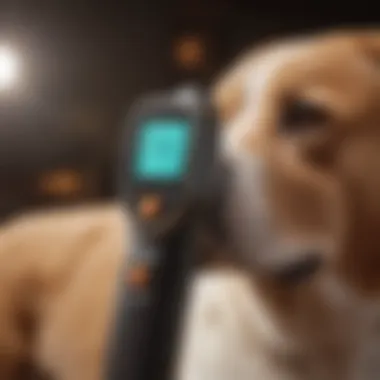Infrared Thermometers for Dogs: A Comprehensive Guide


Intro
The realm of pet care has increasingly focused on technology that enhances the health and wellbeing of dogs. Among such advancements, infrared thermometers have gained recognition for their convenience and efficiency in monitoring canine health. These devices can provide quick and accurate temperature readings, making them invaluable tools for pet owners and veterinarians alike. Understanding how to utilize and interpret these readings can significantly impact your dog's health.
Within this guide, we will explore various aspects of infrared thermometers that every dog owner should know, including the technological foundation of these devices, their practical applications in veterinary practices, advantages for pet owners, and challenges associated with accurate temperature readings. We aim to eliminate any misconceptions regarding infrared thermometers and provide a comprehensive guide to choosing the right device for your dog's needs.
Understanding Infrared Thermometers
Infrared thermometers represent a crucial tool in the assessment of canine health. By understanding their operation and types, dog owners can monitor temperatures accurately and efficiently. This section delves into essential details surrounding infrared thermometers, aiming to educate every pet owner about their importance and proper use for their dogs' well-being.
What is an Infrared Thermometer?
An infrared thermometer is a device that measures temperatures from a distance. It detects the infrared radiation emitted by an object or living being. This technology allows for quick readings without the need for physical contact. This feature can make it particularly advantageous for measuring a dog's temperature, as many pets may resist conventional methods. The non-invasive nature drops the stress for both the animal and owner. Accurate temperature readings can assist in identifying underlying health issues.
How Do Infrared Thermometers Work?
Infrared thermometers operate based on a simple principle. They detect infrared energy and convert it into temperature readings. The device collects the infrared radiation that a dog radiates and processes this energy to provide a temperature number displayed on the screen. Understanding how this process works assures owners of the reliability and effectiveness of these thermometers. They require minimal training to use, making them accessible.
Types of Infrared Thermometers
Different types of infrared thermometers cater to various needs. Choosing the right one is significant for both individual use and veterinary practice. Key types include:
Contact vs. Non-contact Thermometers
Contact thermometers require some physical proximity to the animal, which may not always be ideal. Non-contact thermometers, however, measure temperature from afar, providing a less stressful experience. Non-contact options are preferred for their convenience and speed, especially in moments that demand rapid diagnosis. They avoid the agitation that sometimes comes with physical contact.
Pistol Grip vs. Handheld Models
Pistol grip models are designed for ease of use, offering a trigger mechanism for quick readings. These are often favored for their ergonomic shape, enhancing comfort during use. Handheld models, on the other hand, may be more versatile in readings but can require a steadier hand due to their design. Both types serve unique practical needs, making them valuable in different circumstances. Your choice should align with personal comfort and specific pet care demands.
Importance of Monitoring Dog Temperature
Monitoring a dog's temperature is a crucial aspect of responsible pet ownership. Understanding how temperature variations affect canine health can help owners make informed decisions in caring for their pets. Regular temperature checks can catch potential health issues early, provide peace of mind to pet owners, and assure better overall well-being for dogs.
Normal Temperature Range for Dogs
The normal temperature range for dogs is typically between 100.5°F and 102.5°F (38.1°C to 39.2°C). However, this can vary based on factors such as age, activity level, and breed. It is essential for pet owners to know the typical temperature of their dog so they can identify deviations that may indicate health concerns. An elevated or decreased temperature can be a sign of a health issue requiring attention.
Why Temperature Monitoring is Essential
The importance of temperature monitoring extends beyond mere observation; it encompasses various critical aspects of canine health maintenance.
Early Detection of Illness


Early detection of illness in dogs is a vital benefit of regular temperature checks. When dogs show symptoms like lethargy or reduced appetite, temperature monitoring can provide valuable insight. A rise in temperature may indicate an underlying infection or inflammation.
- Key Characteristic: The ability to identify irregularities in temperature offers owners a proactive approach to health care.
- Unique Feature: This early detection can lead to swift veterinary intervention, minimizing the risk of more severe health complications. The potential for rapid recovery is significantly enhanced when owners respond quickly to changes in their pet's condition.
- Conclusion: Thus, this method can be seen as a beneficial choice within canine health management.
Post-surgery Care
Post-surgery care is another critical area where monitoring temperature plays a significant role. After surgical procedures, dogs may be vulnerable to infections or complications.
- Key Characteristic: Keeping track of temperature helps in assessing the recovery process.
- Unique Feature: A sudden increase in temperature post-surgery may indicate an infection, allowing for timely consultation with the veterinarian. Monitoring temperature can also reassure owners about their dog's recovery status.
- Conclusion: This crucial step in post-operative care not only aids in recovery but also enhances the overall post-surgery experience for both the pet and the owner.
Heat Stress Awareness
Heat stress can occur when a dog is exposed to high temperatures for extended periods. Dogs are particularly susceptible to overheating, which can lead to heatstroke, a life-threatening condition.
- Key Characteristic: Knowing how to monitor temperature daily can help prevent heat-related issues.
- Unique Feature: A temperature reading above 104°F (40°C) can signal excessive heat, prompting owners to take immediate action to cool down their pet. This quick response can be lifesaving in extreme conditions.
- Conclusion: Recognizing the signs of heat stress and acting quickly with measured approaches can protect a dog's health during warmer months.
In summary, an understanding of temperature monitoring is indispensable for dog owners. The knowledge of normal temperature ranges, the importance of early illness detection, post-surgery monitoring, and heat stress awareness contribute to a holistic approach to canine health. Careful monitoring not only paves the way for timely interventions but also nurtures responsible pet stewardship.
Using Infrared Thermometers on Dogs
Using infrared thermometers on dogs plays a crucial role in managing canine health. These devices allow pet owners and veterinarians to monitor body temperature without causing stress to the animal. This non-invasive method is particularly important for dogs that are anxious or have difficulty remaining still for traditional thermometer measurements. Understanding the correct usage and application of infrared thermometers can greatly enhance how health assessments are conducted on dogs.
Step-by-step Guide for Measurement
Preparing Your Dog for the Procedure
Preparing your dog for the procedure ensures a smooth and stress-free experience. First, it is important to keep the environment calm. Avoid loud noises or sudden movements that may frighten the dog. This sets a relaxed tone, which is essential for an accurate reading. Also, ensure that the dog is in a comfortable position to get the best results. A relaxed dog will be easier to handle, leading to a more accurate temperature reading. This approach is beneficial as it confirms that the readings reflect the dog's actual body temperature.
Positioning the Thermometer
Correctly positioning the thermometer is vital for an accurate reading. Hold the thermometer parallel to your dog’s skin, with the sensor aimed at the area where you wish to take the temperature. Typically, the best spot is in the ear canal or the forehead depending on the model used. Ensuring the thermometer is close enough, yet not touching the skin, minimizes the chance of interference from external temperatures. This positioning allows for the infrared sensor to work effectively, providing a quick and reliable measurement.
Interpreting the Results
Interpretation of the results is a crucial final step. Infrared thermometers provide readings typically within seconds. The normal temperature range for dogs is generally between 101°F and 102.5°F. If the reading falls outside this range, it could indicate a health issue. Recognizing abnormal temperatures early can facilitate timely intervention. Thus, understanding how to correctly interpret the results can be vital in ensuring your dog's well-being.
Common Mistakes to Avoid
Avoiding Reflective Surfaces
Using infrared thermometers near reflective surfaces can distort the readings. These surfaces can cause erratic measurements because they may reflect heat. When measuring your dog's temperature, it's wise to ensure that the area is free of mirrors or shiny objects. This awareness enhances accuracy in readings. Recognizing this is a key component of effective temperature monitoring.
Distance from the Dog


The proper distance from the dog is essential for correct measurement. Holding the thermometer too far away can result in a lower-than-actual reading, while being too close can give exaggerated values. Each device will have specific distance guidelines. Following these instructions is crucial for obtaining valid temperature readings. Users should familiarize themselves with their thermometer’s range characteristics to prevent inaccuracies.
Assessment Conditions
Assessment conditions play an important role in ensuring accurate results. Factors such as ambient temperature and the dog's activity level can influence readings. For instance, if a dog has just returned from a vigorous run, their body temperature might be elevated. Performing the measurement in a controlled environment helps achieve reliable results. Understanding these conditions contributes to better temperature monitoring.
Advantages of Infrared Thermometers
Infrared thermometers offer a variety of advantages that make them a preferred tool for pet owners and veterinarians. Understanding these advantages helps in making informed decisions about canine health assessment. This section dissects the benefits of infrared thermometers, showcasing how they can enhance the monitoring of a dog's well-being.
Advantages Over Traditional Thermometers
Non-invasive Measurement
Non-invasive measurement is a cornerstone of infrared thermometers. This method allows for temperature checking without physical contact. For many dog owners, the thought of using traditional oral or rectal thermometers can cause stress both for the owner and the pet. Infrared thermometers eliminate this discomfort, providing a quick and straightforward solution to monitor a dog's temperature. The key characteristic of non-invasive measurement is its ability to assess health without causing anxiety or pain. This makes it a popular choice among dog owners who prioritize their pet's comfort. It greatly reduces any resistance from the dog during the measuring process.
Instant Results
One major feature of infrared thermometers is their ability to deliver instant results. Unlike traditional methods that may take several minutes, infrared thermometers provide readings in a matter of seconds. This immediate feedback is essential for pet owners who need to assess their dog's health quickly. In situations where time is crucial, such as during a sudden illness or injury, knowing the dog's temperature right away can be vital. Instant results help owners respond swiftly, allowing for more timely veterinary intervention when necessary.
Convenience for Home Use
Infrared thermometers are designed for ease of use, making them convenient for home monitoring. These devices are often lightweight and portable, allowing for quick checks any time. This convenience is particularly beneficial for busy dog owners who might struggle to find time for vet visits for temperature checks. Moreover, the user-friendly design means that anyone can use the thermometer, regardless of their experience level. It encourages regular monitoring of a pet’s health, which can lead to earlier detection of potential health issues.
Use in Veterinary Practice
The application of infrared thermometers extends significantly into veterinary settings. They provide a reliable means of checking a dog's health during routine exams or emergencies.
Efficiency in Clinics
In veterinary clinics, efficiency is paramount. Infrared thermometers speed up the process of taking vital signs, allowing staff to attend to more patients in less time. This efficiency improves the overall workflow, benefiting both the veterinary professionals and the pet owners. Clinics that employ infrared thermometers can streamline appointments, making the process less stressful for all involved. The unique feature of their quick operation makes them especially valuable in busy clinics or during peak hours.
Assessment in Emergency Situations
In emergency situations, quick assessments can save lives. Infrared thermometers are invaluable tools during critical moments when swift temperature checks are required. Their design allows for rapid evaluation, which can be crucial in deciding treatment in emergencies. The key characteristic of these devices is their ability to provide immediate data, enabling veterinarians to make informed decisions quickly. The benefit of having accurate temperature readings in a timely manner can be the difference between effective treatment and worsening conditions.
Considerations When Choosing an Infrared Thermometer
Choosing the right infrared thermometer for your dog is critical for accurate health assessments. Dogs cannot communicate discomfort or illness, making temperature readings an essential part of monitoring their well-being. An effective thermometer can help pet owners quickly identify health issues, ensuring timely intervention when necessary. As technology advances, it offers diverse options, creating confusion for consumers. By understanding what to consider, you can select a device that meets your needs effectively.
Factors to Consider
Accuracy and Calibration


Accuracy and calibration are paramount when choosing an infrared thermometer. An accurate thermometer provides reliable results, ensuring you act only when necessary. The key characteristic of an accurate thermometer is its ability to measure temperatures swiftly and correctly without external interference. This is especially beneficial in volatile situations, like monitoring your dog's temperature during a vet visit or an emergency. One unique feature to look for is a calibration certificate that shows the device's accuracy. However, some devices may drift out of calibration over time, so regular checks are essential.
Price Range
Price range plays a significant role in your choice of infrared thermometer. Many high-quality options are available at various price points, making it crucial to define your budget. An affordable thermometer may lack specific features found in premium models, such as advanced sensors or additional measurement modes. It is important to balance cost with the features offered. While lower-priced models can be appealing, investing slightly more for reliable performance could save considerable worry later on.
User-friendliness
User-friendliness determines how easy it is to operate the infrared thermometer, especially during stressful moments. A device that is intuitive and simple to use can significantly enhance the experience for both you and your pet. Look for models that feature clear displays, simple buttons, and straightforward instructions. Many advanced thermometers include features such as backlit screens or voice prompts that can be especially helpful. However, too many complex functionalities can also complicate use, so choose a model that balances innovation with simplicity.
Recommended Models
Best Budget Picks
Budget picks offer a great balance of affordability and basic functionality. These devices typically focus on providing essential features without the frills. The key advantage of budget picks is their accessibility, allowing you to monitor your dog's health without financial strain. However, they may not always provide the same accuracy or durability as higher-end models. It's a worthwhile exercise to read reviews to identify models that have consistently met user expectations.
Top-rated Professional Options
Professional options are designed for accuracy and dependability, often used in veterinary practices. These models may come with advanced features such as higher precision sensors or extended measurement ranges. They represent the best choice if you want to be certain about the temperature readings. However, they can be costlier and might have a steeper learning curve. If you are committed to regular health monitoring, investing in a professional-grade thermometer can pay significant dividends in your dog's care.
Addressing Common Myths
Understanding common misconceptions surrounding infrared thermometers is vital for dog owners. These misunderstandings can lead to incorrect usage, which may affect a dog’s health assessment. By addressing these myths, we gain clarity and promote accurate practices that enhance the reliability of temperature monitoring in dogs. This section will explore the prevalent myths and misconceptions, ensuring dog owners are well-informed about infrared thermometers and the temperature regulation of their pets.
Myths About Thermometer Accuracy
One prevalent myth is that all infrared thermometers provide the same level of accuracy. In reality, accuracy can vary significantly among different models. Some thermometers are not calibrated properly and can produce misleading readings. Owners should always seek devices that offer reliable specifications and have been verified through proper testing. It's important to compare user feedback and expert reviews before making a purchase. This knowledge enables better decisions, assuring the dog receives a correct temperature reading.
Another common belief is that infrared thermometers cannot be used effectively on dogs, especially during movement. While these devices are designed to measure temperature from a distance, capturing a reading while the dog is moving can lead to errors. A steady hand and proper positioning are essential. Owners should practice using the thermometer in a calm environment to ensure they can achieve accurate readings without interference.
"Accuracy is crucial for ensuring the well-being of your pet. Misinterpreting temperature readings can lead to severe consequences."
Misconceptions About Dog Temperature Regulation
Many dog owners believe that dogs do not require temperature monitoring unless showing obvious signs of illness. This misconception can be dangerous. Dogs may not always display symptoms of fever or discomfort, and subtle changes in body temperature could be indicative of underlying health issues. Regular monitoring can serve as an early warning signal, allowing for timely veterinary intervention.
Additionally, some people think that dogs naturally maintain a stable body temperature and that there is little variation. However, dogs can experience significant fluctuations due to various factors such as activity level, environmental temperature, and emotional state. Understanding this variability helps owners recognize when their dog’s temperature deviates from the norm, helping to prevent serious health issues.
In summary, disproving these myths and misconceptions is crucial for ensuring that dog owners utilize infrared thermometers effectively. Knowledge about the accurate operation of these devices and the nature of canine temperature regulation empowers owners to safeguard their pets’ health.
Ending
The discussion about infrared thermometers unveils their significant role in canine health monitoring. In an era where pet owners are increasingly aware of their dogs' health needs, understanding how to accurately measure body temperature is vital. Infrared thermometers provide an efficient alternative to traditional methods, favoring safety and convenience for both the pet and the handler. The benchmarks established in this article guide the reader toward making informed choices.
The Role of Infrared Thermometers in Canine Health
Infrared thermometers are essential tools for tracking canine health. They enable pet owners to quickly assess a dog's temperature without the invasiveness that often accompanies traditional methods. Normal body temperature for dogs typically ranges between 101 to 102.5 degrees Fahrenheit. Detecting deviations from this range can signal underlying health issues, enabling early intervention.
With their ability to deliver instant results, infrared thermometers serve as critical instruments during emergencies and regular health checks. Particularly in situations where a dog may be anxious or in discomfort, this non-invasive approach can reduce stress significantly. Similarly, for veterinarians, the efficiency of these thermometers means that they can more rapidly assess multiple animals in a clinical setting.
One key consideration when utilizing infrared thermometers is ensuring they are used correctly, which has been addressed in previous sections. Miscalculations or misunderstandings regarding operation can lead to inaccurate readings. Therefore, pet owners should always follow the manufacturer guidance to achieve precise results. This reliability makes infrared thermometers not just tools, but necessary allies in the ongoing quest for a dog’s optimal health.







